You are looking at two of the handful of arches known in Jersey City collectively as the Bergen Arches. In my experience, while many people have heard of “the Arches”, few people have a clear idea of what and where they are and even fewer have been there, though many pass beside them as they drive on Rt. 139. The arch to the left is over the remaining roadbed of a trolley line, which is where we’re standing. The one on the right goes over the Erie Cut, a man-made geological formation geographical feature that used to accommodate four railroad tracks. Three of them have been ripped out; the fourth is broken and busted. The Erie Cut is almost a mile long and goes under four or five more arches, though three of them are better characterized as short tunnels.
Unless otherwise indicated, all the photographs in this post are of the Bergen Arches and were taken on December 7, 2014.
I’ve written about the Arches before, extensively. I’m going through the exercise again because, 1) they fascinate me, and 2) I want to discuss them in the terms that danah boyd has established for teen cyberspace hangouts in It’s Complicated: The Social Lives of Networked Teens (Yale UP 2014).
There are major differences, of course. The Bergen Arches is a real location in physical space whereas the spaces boyd has investigated are virtual. Functionally, network spaces exist online; physically, though, the servers that support them have real locations around the globe. However, copies of my photographs of the Arches exist on my Flickr page and so can be accessed by anyone who has Internet access to Flickr. And I am by no means the only one who photographs the graffiti down there. Just how many of us do that, I don’t know. I’d say 10s to 100s.
We’re standing right in front of the upper arch, looking down at the lower arch. Notice the somewhat scuffed and faded graffiti at the base of the arch. I’ve got photos of that wall going back to 2007 and those show four or five paint layers below the one currently visible. The strange big-eyed character at the left, however, is unchanged, perhaps because the location is not particularly desirable; it’s small and peripheral. I’ve got photos of that character in at least two other locations. The dark black lettering in the middle, however, is relatively new. You can make out the letters “MESS.” MESS or MES writes with the PFE crew. He gets up all over the place, though I’ve only got photos from three other locations that I can think of off hand. Finally, notice the black netting in the lower arch. That was installed a year or two ago to catch the crumbling masonry.
One of the themes boyd develops is that of privacy in public. The Internet functions as a public utility and most of the places teens hang out are public spaces; anyone can go there. Some have privacy settings, like Facebook, but using them is somewhere between tricky and a pain in the ass, so most teens simply ignore them. The fact that they don’t mess with those privacy settings doesn’t mean that they’re addressing their remarks to the public large. They’re not; they’re only addressing their friends. And, for the most part, the public at large could care less about what they say – the various snooping agencies and advertisers are not the public at large, nor is it obvious that they have any very clear idea of what they’re doing; they just do a lot of it.
However, steps are taken (p. 65):
Children love to experiment with encoding messages. From pig latin to invisible ink pens, children explore hidden messages when they’re imagining themselves as spies and messengers. As children grow up, they look for more sophisticated means of passing messages that elude the watchful eyes of adults. In watching teens navigate networked publics, I became enamored of how they were regularly encoding hidden meaning in publicly available messages. They were engaged in a practice that Alice Marwick and I called “social steganography,” or hiding messages in plain sight by leveraging shared knowledge and cues embedded in particular social contexts.
That photo dates from July 6 of 2007 and is the oldest photo I have of that wall, which is the wall whose lower edge we saw in the previous photo. There’s a lot of stuff on that wall, and things seem to have been piled atop one another chaotically. There is, however, an informal ethics to that. Unless the existing imagery has been badly degraded by the weather, or by “toys” (novice writers who have more chutzpah than skill), you have to do something better than what you’re going over.
What you’re seeing on that wall is the collective tracings of a community. It’s a conversation on a wall, where the message is, “Hi, it’s me.” But also, collectively, “This wall is ours!” Legally, the wall belongs to CSX, a railroad line, and CSX cops can arrest you if they catch you down there.
Some of the writers in fact know one another in the physical world. But that’s certainly not true of all the writers who have marked that wall – incidentally, “writers” is a term of art in the graffiti world’ it’s what the ‘artists’ call themselves. Now look at the odd orange-brown creature in the middle. It says “Renks” and if you google the name you’ll see he’s from Australia, so it’s unlikely that he knows many of the other writers on that wall face-to-face. But it’s likely that one of them brought him to the wall. How else would he have gotten there? It’s not listed in tour guides.
Some of the writers in fact know one another in the physical world. But that’s certainly not true of all the writers who have marked that wall – incidentally, “writers” is a term of art in the graffiti world’ it’s what the ‘artists’ call themselves. Now look at the odd orange-brown creature in the middle. It says “Renks” and if you google the name you’ll see he’s from Australia, so it’s unlikely that he knows many of the other writers on that wall face-to-face. But it’s likely that one of them brought him to the wall. How else would he have gotten there? It’s not listed in tour guides.
“But what’s a writer from Australia doing in Jersey City,” you ask, “and why?” Simple. He’s getting up; he’s getting fame. Now, in Australia he made the newspapers for writing “Renks” on the windows of an unoccupied skyscraper; he also got six months in jail as I recall. So he’s got his name before a fairly large public. But up here in Jersey City the only people who see that wall are other graffiti writers, homeless people (who sometimes camp out beneath the arches), urban explorers, and the construction workers who have been using the Arches as a staging area off and on in the last two or three years.
And now we get to the Big Point, “Renks” is not the name on his birth certificate. None of the names on that wall are legal names. They’re all names that writers choose as their name in graffiti culture. You and I may see the names, but we don’t know who the individuals are. They’re hiding in public.
Here’s another bulletin board wall:
I took that photo on August 28, 2007. Notice that the wall isn’t masonry. Rather, it’s the surface of the rock that remained after the cut was blasted out of bedrock. This wall contains mostly tags, though take note of that character to the upper right of LOSER, who is the one who did it.
This is a shot of that same wall that I took last Sunday (Dec. 7, 2007).
The angle is wider and we see more names. It’s my impression – which I may or may not be able to verify by going through the 100s if not 1000s of photos I’ve taken of the Arches – that the names around the edges of the image are much newer, especially the one’s higher (15 on 20 feet or more) on the wall. Graffiti is also a competitive sport where you get more “points” for getting up in more difficult spots. Who’s awarding these points? Mostly your fellow writers. After all, they’re the only ones who know who you are.
Now, remember that Loser character? Does this character look like it’s in the same style?
And who stacked the tires atop that iron box? That’s down there in the Arches as well. If a Martian anthropologist were to land here, what would she be thinking about these folks? Is this some kind of shrine?
Back to boyd, where she’s discussing the nature of cyberspace hangouts (p. 11)
Because technology is involved, networked publics have different characteristics than traditional physical public spaces. Four affordances, in particular, shape many of the mediated environments that are created by social media. Although these affordances are not in and of themselves new, their relation to one another because of networked publics creates new opportunities and challenges. They are:
- persistence: the durability of online expressions and content;
- visibility: the potential audience who can bear witness;
- spreadability: the ease with which content can be shared; and
- searchability: the ability to find content.
She uses those affordances to characterize networked spaces. I’m going to apply them to graffiti culture, just to see what turns up.
Persistence: A tricky one. While graffiti got started in New York City and Philadelphia at about the same time, late 1960s, the major early development took place in the New York Subway system during the 1970s and 1980s. There was a pitched battle between graffiti writers and the transit authorities – who saw themselves acting on behalf of the citizens of New York. What this meant, of course, is that none of the graffiti inside or outside subway cars was permanent. Sooner or later it got “buffed.”
The writers new that and adapted to the situation. In the first place, as soon as a car rolled out of the yard and into service where it would be seen by J. Q. Public in general, and others in Graffiti World in particular, the fame points had been earned. Between the intrinsic satisfaction of the work itself – midnight adventure, evading the cops, adrenalin pumping as you and your buddies spayed those cars all freakin’ over WHAT FUN! – and the fleeting registration of that work in the public’s mind’s eye, it was over. None of this eternal universal beauty on a museum wall where the guards look at you funny if you don’t look like you belong, none of that. Those rich 1%er collectors had nothing to do with it. Nada.
And the photographs. You paint it, and then you flick it. That flick is your persistent record. And when the web went live in the mid-1990s flicks of graffiti went up on it. Graffiti is all over the web – not as numerous as porn, nor in the same spaces – but it’s there and is as persistent as anything on the web. Of course, the web didn’t exist at the beginning of graffiti; the basic traditions and practices arose before the web. But when the web emerged, graffiti adapted and adopted it for its own.
Visibility: Again, tricky. If you’re in graffiti culture, you know where the spots are. Citizens of graffiti culture are graffiti’s primary audience. But not the only one. This too is by Loser (taken November 28, 2014):
It’s about a mile away from the Arches, on the side of a Pep Boys shop. It faces the Hudson-Bergen Light Rail where it’s seen by thousands of commuters a day. That’s visibility. That’s a so-called “permission” wall. Loser had the owner’s permission to paint there; he could paint in full light of day without worrying about being hassled by the police. The permission was arranged by Greg Edgell, a local entrepreneur doing business as Green Villain.
This is at the other and of the Pep Boys wall, and it is flat-out stunning (taken November 28, 2014):
It’s by NTEL, also of the AIDS crew. If you look closely you’ll see wording from the Preamble of the Constitution of the United States: “We the People…” I’m not sure what’s going on with the three identical little girls jumping rope in a dress out of the 1950s. They’re rendered in the style of stencil work and may be homage to Banksy, the best-known stencilist in the world. Banksy frequently uses images of young girls.
Notice the magenta crown over the heard of the right-most girl and the small crowns above it, as though they were blown from the heads of the other two girls. Crowns do not get on graffiti pieces by arbitrary artistic choice. They have a special meaning in graffiti culture. Crowns are used to mark a so-called King of graffiti. You’re a King if you’ve mastered the three basic disciplines – tags, throw-ups, and pieces – and have executed a large body of work over several years that is visible in many places. Why, then, are these girls being marked as kings, if that’s what’s being done?
The Bergen Arches run parallel to an active fright line. Graffiti painted on freight cars travels wherever the cars go. Every time I’ve seen a freight train most of the box cars had graffiti on them, and many of the tank cars as well.
Spreadability: Again, this is tricky. The originals on walls are not spreadable at all. Graffiti on trains does travel, but only with freight trains, and that routing is controlled entirely by the railroads. Photographs, on the other hand, spread easily. And a lot of those have spread themselves into books. The first graffiti book, The Faith of Graffiti, was published in 1974, with photographs by John Naar and text by Norman Mailer. Subway Art, by Martha Cooper and Henry Chalfont, came out a decade later. Both of these books have come to be known as “bibles” of graffiti. Copies of them were eagerly passed around from writer to writer back in the day. These days there are a fair number of graffiti books and special interest magazines as well. And, of course, the web.
Searchability: Yep, you got it, tricky. Images of graffiti are as searchable as any images on the web. Where it exists physically, graffiti may well be hidden from those who aren’t in the culture. Most people in Jersey City do not know where the Bergen Arches are, much less that there is graffiti down there. But they may well come across photos of it on the web – FWIW, I often post photos of local graffiti to various Jersey City community groups on Facebook.
Where are we?
Graffiti is like the ordinary networked spaces of teens in some ways, and in some ways it’s different. For that matter, the ordinary networked spaces of teens are also like those for academics in some ways, but different in others. There’s nothing surprising here.
I suppose the thing to do would be to go through this exercise again, this time being more careful to distinguish between graffiti culture as it existed before the web and graffiti culture as it has come to exist after the web. Perhaps I should provide completely separate characterizations of each state. Since I haven’t actually done that – though I’m acutely aware of the distinction – I’m not sure what we’d see.
But I will note a few things.
In the first place, graffiti arose as a medium in which marginal teens, teens from working class and even welfare class backgrounds, black and Latino teens, could proclaim their existence in one of the largest and most powerful cities in the world, New York City. Just as teens are to some extent driven to cyberspace because they can’t hangout in physical space, graffiti writers commandeered their own space on the surfaces of a social space owned by those who for the most part had written them off.
In the context of the web, however, photos of graffiti can be shared like any other photos and in any online space, whether one dominated by teens or not. Moreover, there are plenty of online sites specifically for graffiti, and many of these sites have chat boards. I don’t really know about the demographics of these sites, but I suspect that they skew young, though many of the people who use these sites are likely in their 20s and 30s, the upper reaches of young.
Finally, I note that graffiti has been adopted by hip-hop and by extreme sports. It is a language spoken and written by youth around the world and is the first form of abstract art to find a mass audience. Despite the fact that it emerged before cyberspace existed, is graffiti the native graphic art of the new savanna that is cyberspace? Is it therefore the most important aesthetic movement of the last half-century?
This is one of my favorite walls as it exists today (taken December 7, 20014). You can see a name, “Hemlock,” superimposed over an older piece, one that seems to contain mushroom-like objects, or, perhaps more likely, flying saucers – it’s hard to tell – and bubbles. This is what it looked like when I first saw it (July 6, 2007):
Back then I couldn’t see the lower halves of the letters and so didn’t recognize them as letters. It thought they might be the highly abstracted tops of skyscrapers and I was thus looking at an image of a space city of some kind. I suppose I could have talked through the grass and examined the surface. But, and you can’t tell that this from the photo, that would have required that I step through several inches of mud and water. Unh, uh, not today, not in my new kicks. No sir.
December 9, 2007.
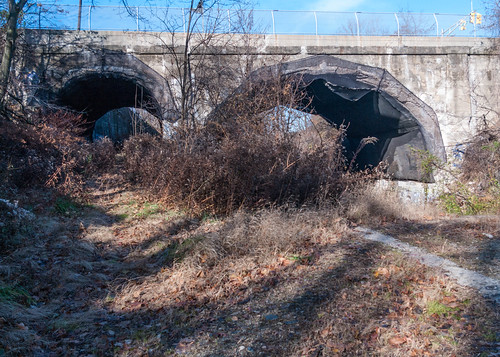
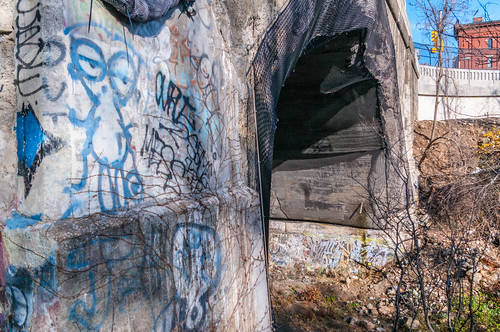
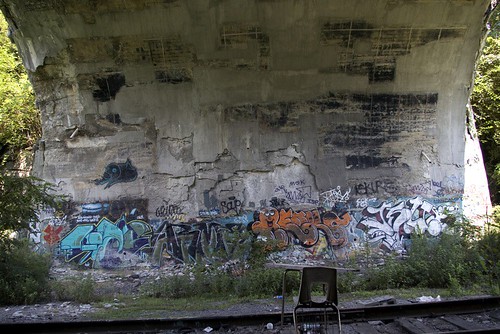
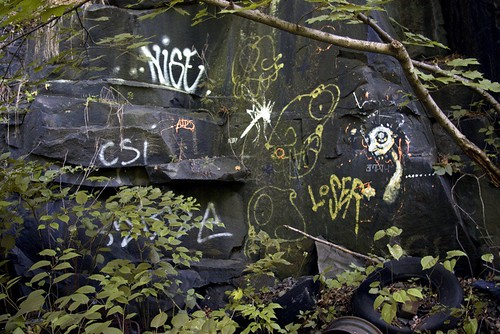

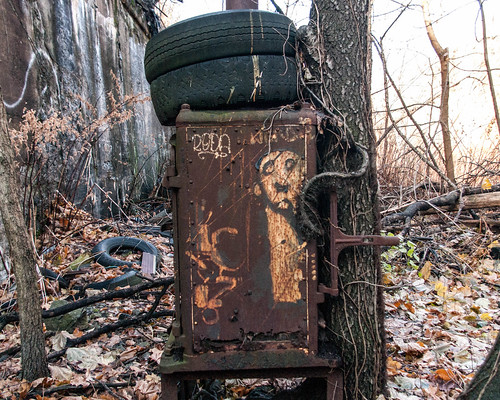
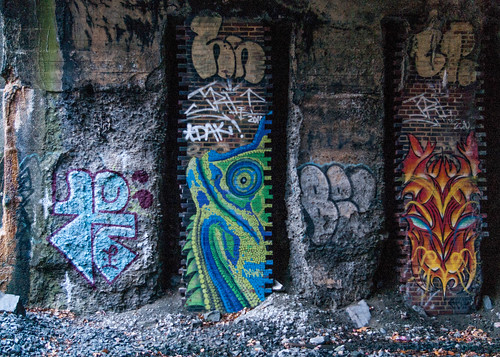


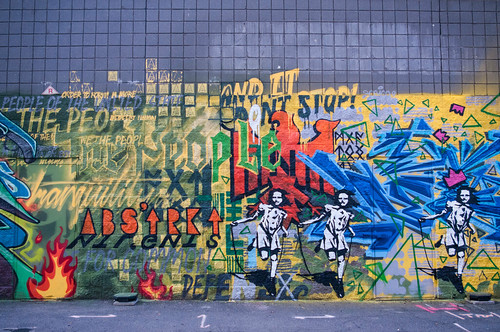


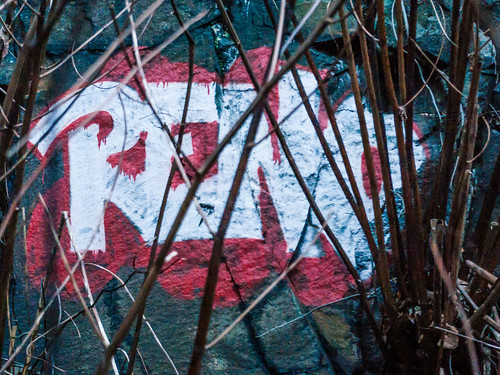
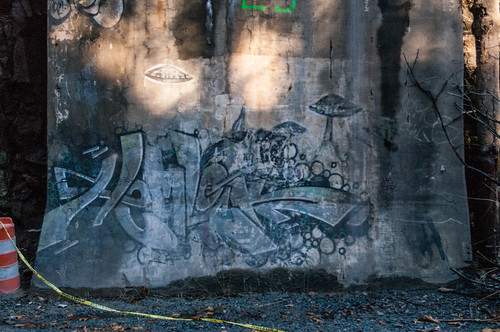
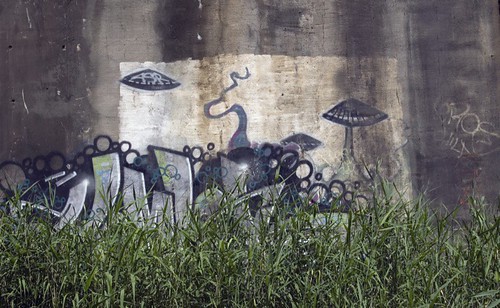
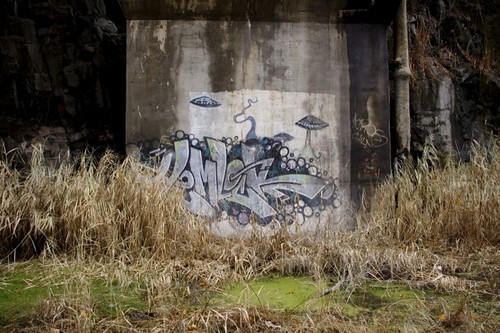
Bill this is a fantastic piece of work. Thank you. I have been thinking about graffiti the past few days as an ongoing investigation into the nature of freedom (framed). I shall be back to browse this and to reflect. Brilliant timing for me. Thanks
ReplyDeleteI agree with Simon, I really enjoyed the analysis and the evolution of time over messages that are in many ways right or near in front of us but not understood.
ReplyDeleteIt's interesting how the shared culture you describe seems to have evolved (the meaning of the crown, the respect of prior art) rather than designed. I'm thinking about my own interests where I live in the earlier marking in the desert southwest of petroglyphs, where mostly we can make wild inferences as to intent and meaning.
Thinking too at where the shift is from graffiti perceived as nuisance on rail cars and undesirable alleys to the art on the side of Pep Boys.
One quibble on wording because of my own training; the Erie Cut is not a geological formation; those are the names for the layers and units of ancient rock we see now- it's more of a man made geomorphology. Not that it matters.
Thanks again- I mostly seeing what people are passionately interested in and how they communicate it.
Thanks guys. Yes, Alan, I was aware of a discordance with the term "geological formation" when I typed it. I just didn't know what else to call it. I suppose "geographical feature" would have been better. I'll change it.
ReplyDeleteI had two visits to the Cadillac Ranch... Talk about ephemeral, I bet stuff does not last more than 48 hours
ReplyDeletehttps://www.flickr.com/search/?w=37996646802@N01&q=cadillac+ranch
Did you notice the "peace" sign in this photo, Alan:
Deletehttps://www.flickr.com/photos/cogdog/6361520289
That symbol is quite common in graffiti.
You sly devil, you:
Deletehttps://www.flickr.com/photos/cogdog/6361556669
You caught me! I also got some #ds106 up as well
ReplyDeletehttps://www.flickr.com/photos/cogdog/6361547329
Who's got the aerosol concession for the place?
ReplyDelete“social steganography,”
ReplyDeleteInteresting term. Sort of inspires me to try and take more time with writing I love this form of patterning and layering not to hide but to add depth and its an easy way to remember lots of stuff as you can load a word, image in multiple ways with lots of information or directions on where to go.
I use to enjoy patterning reference systems in essays in particular, with subjects I knew well, its fun. Like a 3d pattern, turns words into something else that are more understandable as they start moving and forming things.
@Simon: I've got quite a bit on the blog about graffiti. Many of the posts are just photos, but those tagged "graffiti essay" and "graffiti aesthetics" should have some substantial text. Also, I've just created a working paper from some posts I did a couple of years ago while working my way through Bruno Latour's Reassembling the Social. I used graffiti as a running example; you can get that working paper HERE.
ReplyDelete@Alan: I just wanted to underline what you said about graffiti evolving. Back in the early days no one had any idea it would evolve as it did. When Mailer called graffiti art back in The Faith of Graffiti, there was nothing on those subway cars that looked like art. A decade later than had changed. I suppose Mailer was responding to the existential urgency of graffiti rather than its visual appeal. But that urgency quickly enough generated visually compelling images.
What's particularly interesting to me is the fact that graffiti is, technically, vandalism. I think that is in part WHY it has flourished, though I'm not quite sure why that is so. Yes, there are permission walls like the Pep Boys mural, but the writers who do them continue doing "illegals" to maintain their street cred.
Also, Alan, it doesn't seem to me that any of the graffiti on those planted Cadillacs was done by graffiti writers. There's little or no "style" there. It's just ordinary folks with spray paint. Which is fine, of course. But, at the periphery of many graffiti sites you'll see random crap where writers just spray stuff; sometimes they're checking to see the color of the paint, or opening a clogged cap. I find these areas quite appealing, and have a number of photos of them under the label "graffiti chaos." And the walls of bathrooms in clubs requented by graffiti writers...
Now, if you want to work on your can skills and develop some nice tags, aka as hand styles, "cogdog" and "ds106" would make fine graffiti tags.